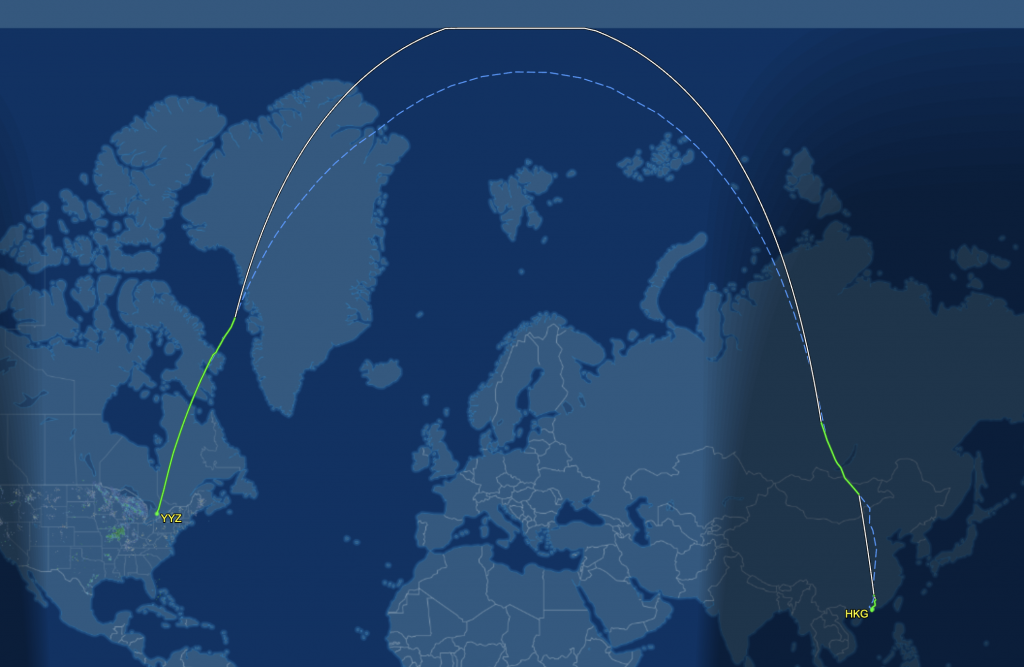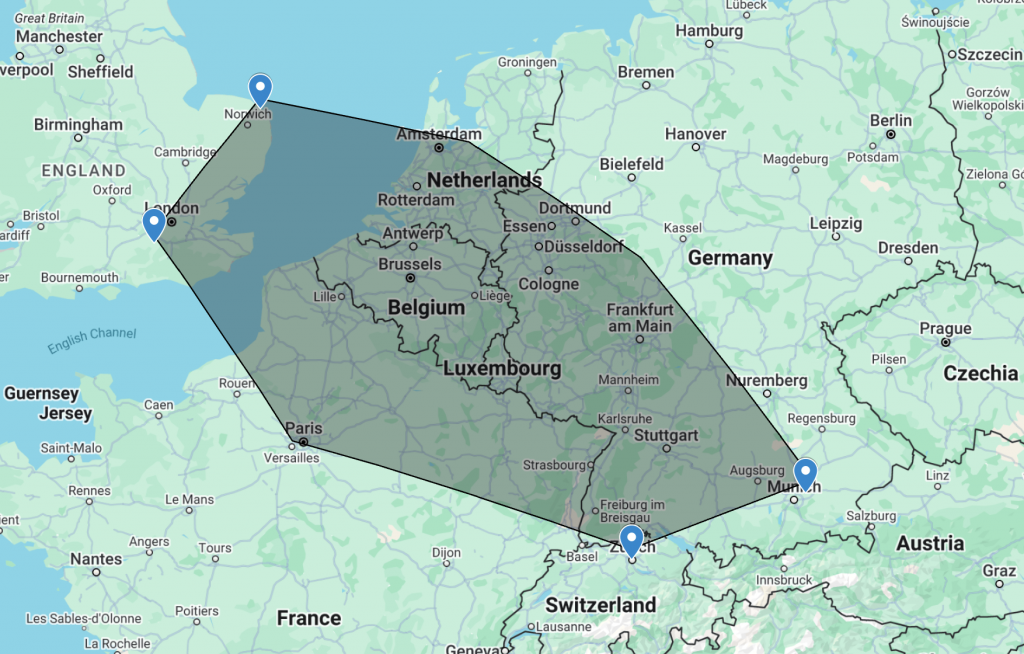
Density
I don’t understand how the world is put together. It’s certainly networked. But how, exactly, is elusive. I understand that it has something to do with density. Here’s an explanation from that point of view.
CX 829 leaves from Toronto around 2 am in the morning, flies North, over the pole, and then south, landing in Hong Kong 15 or 16 hours later, the next day, at something like 4 or 5 in the morning. It’s kind of like passing a portal into a tube, going to sleep, watching a few movies, then a nap, and waking up the next day in another version of the world.
Canada is massive. You fly over it for around five hours without…flying over not too many people at all. You don’t get to see many twinkling lights past Orillia. There really isn’t much at all for the next nine hours. There are animals and plants down there until there isn’t. If you’re heading over in the summer, the sun comes up sooner, but it’s usually cloudy so you don’t see the Canadian shield. Every time I’ve flown over in the summer, I haven’t ever seen any of the gorgeous islands. If it’s winter, it’s dark pretty much the whole way up and down.
I like to stay up until we’re over the North Pole, I stand up, do a little dance to mark the moment, savour it, and then I allow sleep. It’s silly but it thankfully doesn’t happen to me every day.
It’s only after flying for twelve or fourteen hours that you start to fly over one of the densest areas by population on Earth.

North America has, broadly, four primary wealth concentrating cores: The North East Core, which is defined by the I-95 super-city in the East, Toronto in the North, Chicago in the West, and roughly Cincinnati in the South. The Texas Triangle. The Bay Area. And I’ll put CDMX into that top four.
The I-5 Corridor, LA, Denver/Inter-Mountain West are honourable mentions but they aren’t quite on the same density or scale in terms of GDP/KM^2 as the first four. And that’s just for North America.
From a global perspective, the NE-Midwest-I-95 super-city core is a massive one. Raw commodities from the West and North pour into Chicago and South-West Ontario, are transformed within a few nodes in-between rusted out ones, and exchanged with knowledge and dense information nests along the I-95 corridor. A lot of the unproductive conflict these days has to do with the geographic centre of this core.
Globally, in addition to the NE-Midwest-I-95 super-city, there are two other globally significant cores.
The Coast of China running from Zhanjiang in the SW to Dalian in the NE is another. One could argue that it extends across the straight to Taiwan, and over to South Korea and then a bit further out to Japan to complete a NE Asia Core.
For the third one, draw a line from south London to Norwich, it’s something like 300 km wide, and then draw a line between Zurich and Munich, again, something like 300 km wide, and connect them into a rough quadrilateral – a bit of a dog leg for Paris – to get the NW EU core.

So, globally, you got the NE North American core, the NW Europe core, and the NE Asian Core. Each has peripheries and there’s whole lot of hinterland in every direction around them [1].
Density drives specialization, and with specialization: wealth.
The density within those cores is transformative.
These cores take in tremendous quantities of matter, energy, and people — transform them — and pump out complex products. And waste. They transform sand, water and rare minerals into supercomputers you carry in your pocket. They transform basic energy into complex structured EM radiation and spray them everywhere: television, radio, and electrical impulses through wires. And they transform relatively gentle people who enjoy simple drip coffee into raging lunatics who enjoy being seen to drink a latte with a watch on their wrist that desperately up-signals a desire to be accepted or to be the monkey in charge of all the bananas.
Consider the NW European Core. In it, they’ve figured out how to persuade a crystal to grow into an shape hard enough to survive tremendous forces in an aircraft jet engine. They’ve also figured out how to build the machines that help sand re-organize itself into useful crystals that respond to EM forces selectively, all in total darkness, all with precision that is finer than light itself. It’s wild what they’ve figured out there.
In the NE North American Core, they’ve created terrifying robotic dogs. They figured out a spell they cast on the world that persuades nearly anybody that it’s safe to encode capital there, in a way that’s interoperable, and where judges know just enough to secure rights, but remain just ignorant enough to let the lawyers invent all sorts of exotic grimoires. They’ve also figured out how to say words that make people want things that they wouldn’t ordinarily want, and then further package capital so as to persuade large numbers of people to pay money to pay money for things they wouldn’t have wanted if they hadn’t been exposed in the first place. They make capital appear out of thin air. They’ve gotten so good at this. And it’s wild that they’re messing with the beliefs that underpin these beliefs in the first place.
In the NE Asia Core, they figured out how to take hundreds of instructions to make something, break them down into the smallest units, and massively parallelize them. This core eats mountains of minerals and hydrocarbons and pumps out enormous quantities of every luxury and basic consumer product, at scale, all the time.
Life In The Cores
You don’t see the outside much from inside a core. Space-time is bent in strange ways. You’re just living your life. You write blog posts about cores. You abide by quite a few agreements so as not to upset too many people.
There’s competition inside cores, so there’s pressure to differentiate. You differentiate by defining every finer distinctions across different fields of being. If you’re status driven, you need to find a kind of watch that you’re aware signals to people that you could afford to be seen with a watch that’s important to them. Watching watchers of watches seems to be extremely important to a set of watched people. If you’ve already made it to a place where you watching the watch watchers watching, you can afford to find the best watch for you. Like a watch that watches you and sends notes if your body is experiencing something you may not be aware of. And that’s just the distinctions people make about others with respect to a single, trivial, article of clothing.
Don’t get me started on shoes.
In general, you get better at some things and worse at others. There’s a pressure that’s barely visible but omnipresent.
It is alienating.
You’re living on top of everybody and there is heterogeneity. Back to those different agreements we make so as not to upset one another. You make an agreement to not talk too literally about watches. And dozens of other conventions. These are at various stages of agreement in different contexts. The Japanese learn to shut up on public transit. The Canadians seem to be having a problem with this idea sometimes. It’s strange that for some, watching a youtube video on full volume on the subway, without headphones, is perfectly fine because what’s your problem I’m just watching YouTube at full volume.
The density makes problems visible because the forces caused by density don’t enable much to hide.
Life in Peripheries
The core can stay over there, we do things differently here. If it isn’t broke, don’t fix it. Traffic is caused by other people. I’m not traffic. Other people are traffic but I am not. Other people should pay more taxes than I pay. I should not be inconvenienced by density. I should be protected from density. I should be protected from any friction, at all times, constantly.
Like a good neighbour, stay over there.
But the core never does stay over there, does it? It’s radiating information all the time. The news cycles are driven there. Ideas are driven there. What ever will they come up with next.
Most people just want to live their lives.
Life in Hinterlands
Nobody cares about us. But we do. We care for us. They might like latte but we like coffee. They need to stop making rules for themselves that affect us. They need to respect us. We don’t get respect out here. What’s the price of the main commodity that drives our economy? What’s oil doing? What’s iron doing? What’s timber doing? What’s lobster doing?
Most people just want to live their lives free from the noise, pollution, and disaster of the core.
But all the cores problems are dumped out there.
Capital Accretion
Experiencing Napoleon’s tomb caused so many conflicting emotions. I wanted to laugh, howl really. Because it is ridiculous. How could such a small man demand such a massive tomb? The entire … complex … is over the top. I admired the effort and craft that went into it. I admired what the generation that put it together had done. I appreciated that they were trying to make feel awe. I saw them trying to awe me, nodded at them, and carried on. Okay, it’s impressive. But it is funny. You need to laugh a bit. Maybe it really wasn’t entirely about him, but the revolution? Still though, I would have preferred a monument to the women of Paris who made it all happen. The hard work of the revolution was already done by the time Napoleon came around. But that’s just such a Canadian reaction to a monument.
Of course, it wasn’t just that generation that performed such a feat. Paris is doted with a monument that each generation builds to shout that they existed.
Nous étions ici.
I suppose.
I think of all the hours of hinterlanders, toiling, many of them without consent, to build up those monuments. I think of all the taxation without representation. That Nous isn’t an inclusive Nous.
I thought of the Canadian version of this. There is the CN Tower, which was the Greatest Generations way of telling us to go for it. There was a generation of folks born 1880s, the Lost Generation, that built these giant stone cenotaphs after the Great War and poured all their sorrow into them. There are over 6,200 war memorials in Canada in total. They tend to be dedicated to groups of people, not often to individuals. Which, in part, causes the dissonance of Napoleon having a massive tomb, and these kinds of Canadian sized memorials to the people who never came back.
Societies build artifacts of their memories: paintings, fountains, sculptures, monuments, stadia, pillars, towers, bridges, books, stories, language, songs, dances, castles, estates and triumphs.
And then there’s the visible-invisibility of the bond markets which in each one of those global cores: New York, London, Tokyo-Shanghai-Hong Kong.
Capital is accreting.
Inequality
Density seems to accelerate inequality. Which might not be a bad thing so long as inequality doesn’t generate too many externalities. There’s that debate about externalities. If inequality is inevitable, then better make it rational.
In the hinterland, when a single person has density, when they own the corporation that owns the mine, their advantage accrues. They can then buy the local general store, issue their own currency in script, buy the newspaper, then the politicians and the sheriff. They kind of behave like a Viking Norman showing up off the coast in 1066. If you look closely enough you can just barely make out the difference. From the conquerors perspective, they have the capital, so they have the liberty. I am strong, you are weak, you belong to me. From the hinterlanders perspective, they, themselves, should have liberty as well. They should be able to live a good, free, life. After all, they don’t live in the core for a reason.
The periphery wants the density over there in case they need something real fast and conveniently (why can’t there be a tunnel that runs direct from my house to downtown?), and the void, with all its bears and coyotes, way, way over there. They want just as much liberty as necessary to live their lives.
But not too much liberty. Too many varieties of peanut butter at the grocery store, that’s dehabilitating. Maybe there’s demand for ninety kinds of peanut butter and various nut spreads New York or Toronto. But here, we like our peanut butter either smooth or chunky and with a lot of a sugar.
In the core, the memory is supposed to be that you don’t allow a single person to become too dense. Constantinople and Rome alike dripped in intrigue about such debates.
It doesn’t seem designed
I don’t understand how it’s put together, but it has something to do with density, doesn’t it?
Density of people, material, means, opportunity, ideas, power, capital and memories?
It doesn’t seem designed. A core takeaway from the 20th century was that if one designs too much rigidity, too much inequality, into the system, then humanity would shake that system apart. And that wasn’t great.
We’re dancing on the edge of chaos and order. Not too much one way. Not too much the other.
Given that nature, it might be good to be somewhat intentional about a few things, and perhaps, let a few other things be a bit more wild?
Notes
[1] India is coming along, and have their own long game in mind. Not quite a massively exporting core just yet. Respect.
